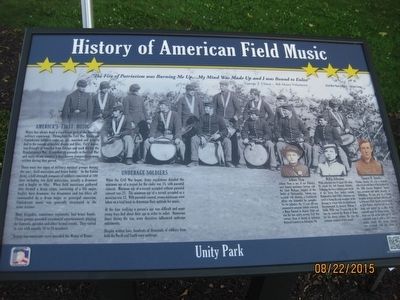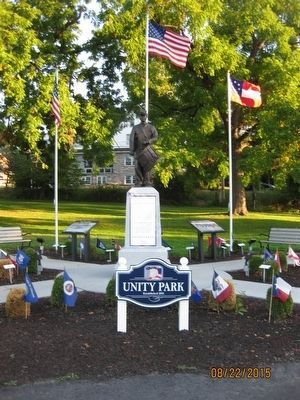Gettysburg in Adams County, Pennsylvania — The American Northeast (Mid-Atlantic)
History of American Field Music
Unity Park
"The Fire of Patriotism was Burning Me Up...My Mind Was Made Up and I was Bound to Enlist"
George T. Ulmer - 8th Maine Volunteers
America's First Music
Music has always been a significant part of the American military experience. Throughout the Civil War, Union and Confederate soldiers woke up, ate, marched and went to bed to the sounds of bugles, fifes and drums. Field Music was brought to America from Europe and used during the Revolutionary War. It reached its pinnacle in the Civil War and many of our country's best known compositions were written during that period.
There were two types of military musical groups during the war: field musicians and brass bands. In the Union army, a full-strength company of soldiers consisted of 100 men including two field musicians, usually a drummer and a bugler or fifer. When field musicians gathered they formed a drum corps; consisting of a fife major, bass drummer, ten drummers and ten fifers all commanded by a drum major or principal musician. Confederate music was generally structured in the same manner.
Many brigades, sometimes regiments, had brass bands. These groups provided ceremonial entertainment, playing for funerals, parades and other formal events. They varied in size with usually 16 to 24 members.
Twenty two musicians were awarded the Medal of Honor.
Underage Soldiers
When the Civil War began army regulations detailed the minimum age of a recruit for the ranks was 18, with parental consent. Minimum age of a recruit accepted without parental consent was 21. Minimum age of a recruit accepted as a musician was 12. With parental consent, young musicians were taken on a trial basis to determine their aptitude for music.
At the time, verifying a person's age was difficult and many young boys lied about their age in order to enlist. Numerous times during the war, army directives influenced underage enlistments.
Despite written laws, hundreds of thousands of soldiers from both the North and South were underage.
Johnny Clem
Johnny Clem is one of our nation's most famous musicians. Serving with the 22nd Michigan Infantry at the Battle of Chickamauga, Johnny was credited with shooting a Confederate officer who demanded his surrender. For his gallantry, the 12 year old was promoted to sergeant; Johnny retired as a Major General in August 1916 and was the last active serving Civil War veteran. Clem is buried in Arlington National Cemetery in Arlington, Va.
Willie Johnston
Willie Johnston was 11 years old when he joined the 3rd Vermont Infantry. Following the fierce fighting and retreat of the Seven Days battles outside of Richmond in June 1862, Johnston was noted as being the only drummer in the division to return with his instrument. Recommended by General William F. Smith; Willie was 13 years old at the time he received the Medal of Honor for his heroic actions. He was the youngest recipient of this award.
Thomas H. Sparks
Thomas Sparks, 18, was a drummer who served with three of his brothers in the 59th Georgia Regiment. Sparks was wounded and taken prisoner in Gettysburg. He was sent to a Union hospital, paroled, and back with his unit in February 1864. Sparks was in battle at Cold Harbor when he laid down his drum and picked up a rifle, being captured again by Union troops. The drum was left on the field and he was separated from it until a 1915 news article sought the owner. Sparks was reunited with his drum in January 1916.
(caption)
61st New York Infantry—Drum Corps
Erected 2015.
Topics. This historical marker is listed in these topic lists: Arts, Letters, Music • War, US Civil. A significant historical year for this entry is 1862.
Location. 39° 49.522′ N, 77° 13.822′ W. Marker is in Gettysburg, Pennsylvania, in Adams County. Marker is at the intersection of Lefever Street and Wainright Avenue, on the right when traveling east on Lefever Street . Located 60 yards east of Baltimore Street in Unity Park. Touch for map. Marker is at or near this postal address: 1 Lefever Street, Gettysburg PA 17325, United States of America. Touch for directions.
Other nearby markers. At least 8 other markers are within walking distance of this marker. Unity Park (here, next to this marker); Communications Through Music (here, next to this marker); Unity Through Music (here, next to this marker); Dr. Rufus Benjamin Weaver (here, next to this marker); The Old Well (within shouting distance of this marker); The Evolution of Gettysburg's "Common School" (within shouting distance of this marker); "if anyone showed himself…" (within shouting distance of this marker); Baltimore Street: An Historic Corridor (within shouting distance of this marker). Touch for a list and map of all markers in Gettysburg.
Credits. This page was last revised on May 31, 2020. It was originally submitted on August 28, 2015, by Bill Donovan of Maplewood, New Jersey. This page has been viewed 407 times since then and 20 times this year. Photos: 1, 2. submitted on August 28, 2015, by Bill Donovan of Maplewood, New Jersey. • Bernard Fisher was the editor who published this page.

